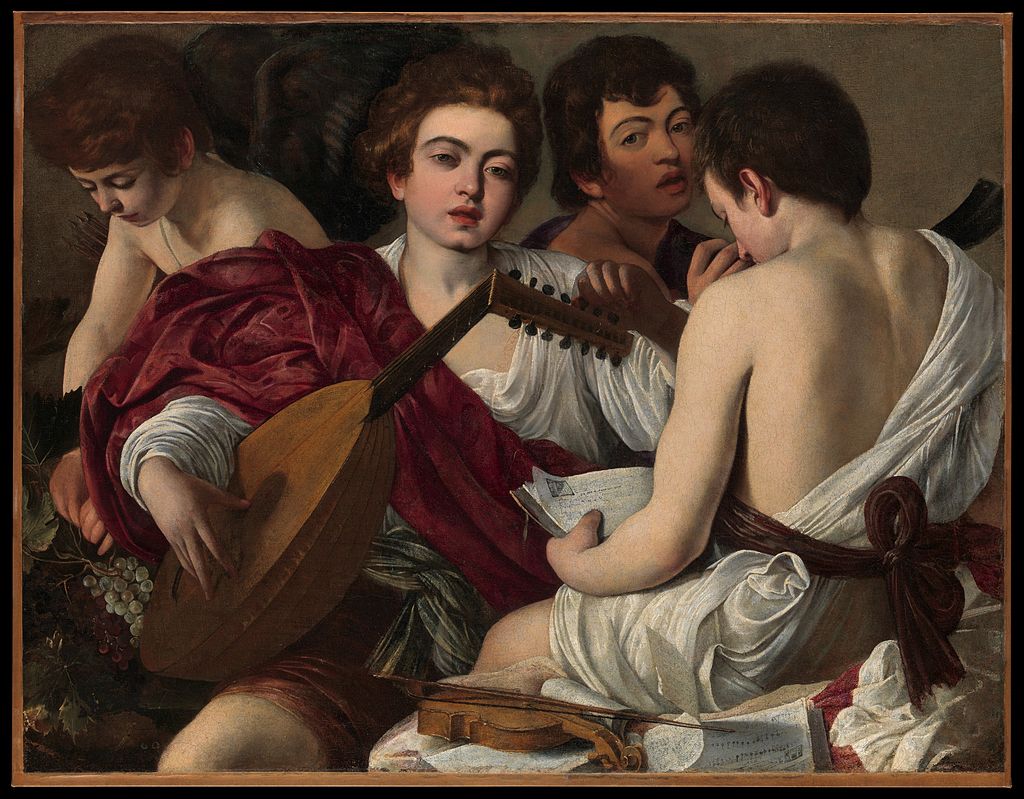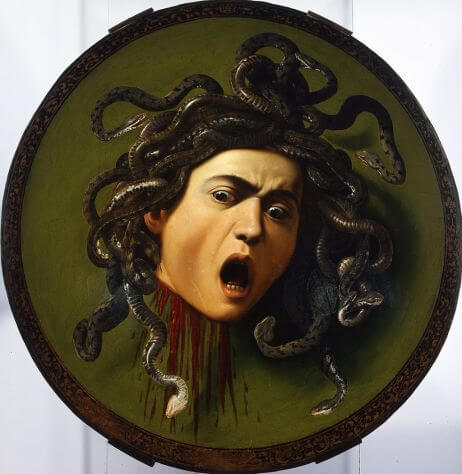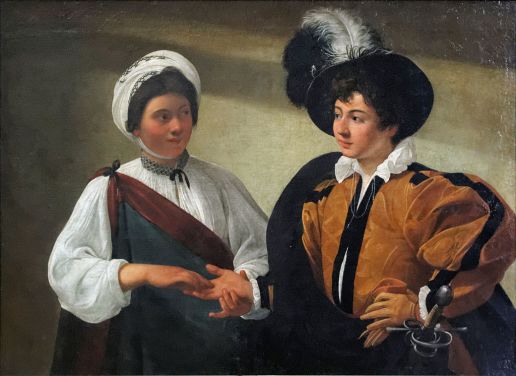|
Where? Room 21 in the Palatine Gallery in the Palazzo Pitti
When? 1608 Commissioned by? Fra Francesco dell'Antella, the Florentine secretary to Alof de Wignacourt, who was the Grand Master of Malta What do you see? A somewhat chubby child is sleeping. The child represents Cupid, the god of desire, erotic love, affection, and attraction. Cupid is resting with his head on top of his quiver with arrows and is holding an arrow (with a small piece of red) in his left hand. You can also recognize the bow with a broken string in front of his legs. The wings of Cupid are also present. While the left wing is clearly visible, the black background hides a large part of the right wing of Cupid. Backstory: Caravaggio created this painting while he was on Malta, where he became an honorary knight. It is the only painting he created there that is known with certainty, evidenced by an inscription on the back of the painting (though he probably created several others in Malta as well). The sleeping Cupid became a popular topic in Renaissance art after Michelangelo’s sculpture of a sleeping Cupid in 1496 (this sculpture is lost, probably it got destroyed in a fire in London in 1698). Michelangelo’s sculpture, in turn, was inspired by old Greek statues of the sleeping Cupid. Symbolism: The depiction of Cupid, with his broken bowstring and his arrows aside, represents the abandonment of earthly pleasures. Whereas an active Cupid is typically seen as a symbol for spreading the love, this particular representation has a completely different meaning. The painting was commissioned by a friar to remind him and others of their vow of chastity. Who is Cupid? Cupid (Eros in Greek) is the god of desire, erotic love, affection, and attraction. He is the son of Venus and Mars. He is often portrayed as a chubby boy. His main attributes are his bow and arrow, and he typically has two kinds of arrows. The first kind are arrows with a sharp golden tip, which can fill someone with uncontrollable desire. The second kind are arrows with a blunt tip of lead, which can fill someone with aversion and the desire to flee. Why Cupid? As Cupid can both fill someone with uncontrollable desire and fill someone with aversion, he makes a great subject for allegories. Love and hate have always been great topics for art as they represent some of the strongest emotions that people possess. The particular way in which he is represented in an artwork can tell a wide variety of different stories. The subject of a sleeping Cupid was already frequently used by the ancient Greek, who mainly used this subject as a symbol of love as an everlasting emotion, which is present whether someone is awake or asleep. Caravaggio has also included Cupid in some of this other works, such as his painting The Musicians in the Metropolitan Museum of Art.
Who is Caravaggio? Michelangelo Merisi da Caravaggio (1571-1610) is a student of Simone Peterzano, who in turn was a student of Titian. Caravaggio had an important influence on the formation of the Baroque period. So much so, that the followers of his style are referred to as Caravaggisti. While Caravaggio never had a school to share his techniques with others, his work has had a big influence on artists like Rubens, Bernini, and (indirectly) Rembrandt. Caravaggio created many masterpieces including his Medusa in the Uffizi Museum and The Fortune Teller in the Louvre.
Fun fact: Quite some people have commented on this painting, stating that the child looks dead. An analysis by a doctor, published in the famous medical academic journal The Lancet, states that the sleeping Cupid suffers from juvenile rheumatoid arthritis. Symptoms include the yellowish skin of the child (indicating jaundice), the blue/purple color in the lips and ears indicates a low level of oxygen saturation, his body seems to suffer from edema, and his joints are inflamed. The question remains why Caravaggio would paint a sick or dead child. It could be an effective way to deliver the message of the painting, or it could be a macabre joke of Caravaggio (which is certainly not impossible given the turbulent life that he lived).
Interested in a copy for yourself? Poster or canvas
Written by Eelco Kappe
References:
0 Comments
Leave a Reply. |
Categories
All
|
- Home
- Blog
-
Museums
- Alte Pinakothek
- Art Institute of Chicago
- Baltimore Museum of Art
- Barber Institute of Fine Arts
- Bargello
- Barnes Foundation
- British Museum
- Church of Sant’Anastasia
- Cleveland Museum of Art
- Courtauld Institute of Art
- Detroit Institute of Arts
- Frans Hals Museum
- Galleria Borghese
- Gallerie dell'Accademia
- Getty Museum
- Guggenheim
- Hermitage Museum
- Kunsthistorisches Museum
- Kunstmuseum Basel
- Legion of Honor Museum
- Louvre
- Mauritshuis
- Metropolitan Museum of Art
- Musee d’Orsay
- Museum of Fine Arts in Boston
- Museum of Modern Art
- National Gallery in London
- National Gallery of Art
- National Museum in Poznań
- Norton Simon Museum
- Ny Carlsberg Glyptotek
- Palace of Versailles
- Palazzo Pitti
- Palazzo Vecchio
- Petit Palais
- Philadelphia Museum of Art
- Prado
- Pushkin Museum
- Ravenna Art Museum
- Rijksmuseum
- San Diego Museum of Art
- Santa Maria delle Grazie
- St. Peter's Basilica
- Städel Museum
- Statens Museum for Kunst
- Tate Britain
- Tate Modern
- Timken Museum of Art
- Uffizi
- Vatican Museums
- Wallace Collection
-
Artists
- Altdorfer
- Anguissola
- Berlin Painter
- Bosch
- Botticelli
- Boucher
- Bronzino
- Bruegel the Elder
- Brunelleschi
- Cabanel
- Caillebotte
- Canova
- Caravaggio
- Carpeaux
- Cezanne
- Cimabue
- David
- Degas
- Delacroix
- De Maria
- Donatello
- El Greco
- Fontana
- Fra Angelico
- Fragonard
- Gauguin
- Gentileschi
- Gericault
- Gonzalez-Torres
- Goya
- Hals
- Hogarth
- Hokusai
- Ingres
- Leonardo da Vinci
- Lippi, Filippo
- Longhi, Barbara
- Lorrain
- Makovsky
- Manet
- Massys
- Matisse
- Merian
- Michelangelo
- Mochi
- Modigliani
- Monet
- Panini
- Parmigianino
- Perugino
- Picasso
- Pisanello
- Raphael
- Rembrandt
- Renoir
- Reynolds
- Rivera
- Rodin
- Rubens
- Scultori
- Seurat
- Steen
- Tintoretto
- Titian
- Toulouse-Lautrec
- Turner
- Uccello
- Van der Weyden
- Van Dyck
- Van Eyck
- Van Gogh
- Van Hemessen
- Vasari
- Velazquez
- Vermeer
- Veronese
- Vigée Le Brun
-
Locations
- Books
- About Us




